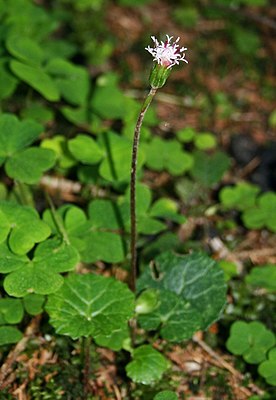Alpine lettuce
| Alpine lettuce | ||||||||||||
|---|---|---|---|---|---|---|---|---|---|---|---|---|

Alpine lettuce ( Homogyne alpina ) |
||||||||||||
| Systematics | ||||||||||||
|
||||||||||||
| Scientific name | ||||||||||||
| Homogyne alpina | ||||||||||||
| ( L. ) Cass. |
The Homogyne Alpina ( Homogyne alpina ), also Green Alpenlattich or Usually Alpenlattich called, is a plant from the genus Brandlattich ( Homogyne ) in the family of Compositae (Asteraceae).
description
Vegetative characteristics
The alpine lettuce is a perennial herbaceous plant that reaches heights of 10 to 40 centimeters. The "rhizome" is creeping and woolly scaly. The upright stem is often reddish brown and ends in just a flower head. It is hairy, silvery-woolly, later bald and usually has two small scaly leaves. The leaves are basal, long-stalked, leathery, coarse and shiny dark green, the underside is lighter. The leaf blade is heart-kidney-shaped.
Generative characteristics
The flowering period is between May and August. The flower heads have a diameter of up to 25 millimeters. The bracts are single row, brownish-red colored and hairy at the base. The flowers are reddish and longer than the basket shell, the corolla lobes are purple. The achenes have a long, snow-white pappus.
The number of chromosomes is 2n = 120, 140 or 160.
Similar species
The felt lettuce ( Homogyne discolor (Jacq.) Cass. ), Which is similar to the alpine lettuce , which occurs in the Eastern Alps, differs through the white felted leaves on the underside.
ecology
The alpine lettuce is a humus creeper . It is a partial shade plant . The pollination is done by insects, such as flies and moths or self-pollination .
Occurrence
The distribution area of the Alpine lettuce includes Spain, Andorra France, Italy, Switzerland, Germany, Austria, Liechtenstein, Slovenia, Croatia, Albania, the Czech Republic, Poland, Slovakia, Bosnia-Herzegovina, Serbia, Montenegro, Bulgaria, Romania, Macedonia and Ukraine. The alpine lettuce occurs in the mountains of southern Central Europe at altitudes of 500 to 3000 meters. In the Allgäu Alps, it rises from altitudes of around 530 meters in Baden-Württemberg near Doberatsweiler, a district of Achberg , to 2384 meters at the Rauheck summit in Bavaria.
The alpine lettuce grows on moist, humus-rich, mossy soils in coniferous forests, bushes and dwarf shrub heaths. Homogyne alpina is a character species of the association Piceion, but also occurs in societies of the Nardion or Seslerion.
Taxonomy
The first publication took place in 1753 under the name ( Basionym ) Tussilago alpina by Carl von Linné . The new combination to Homogyne alpina (L.) Cass. was published in 1821 by Alexandre Henri Gabriel de Cassini . Another synonym for Homogyne alpina (L.) Cass. is Tussilago sylvestris Scop. nom. illegal.
literature
- Xaver Finkenzeller, Jürke Grau: Alpine flowers. Recognize and determine (= Steinbach's natural guide ). New edited edition. Mosaik, Munich 1996, ISBN 3-576-10558-1 .
Individual evidence
- ↑ a b c Werner Greuter (2006+): Compositae (pro parte majore). In: W. Greuter, E. von Raab-Straube (Ed.): Compositae. : Datasheet Homogyne alpina In: Euro + Med Plantbase - the information resource for Euro-Mediterranean plant diversity.
- ↑ a b c Erich Oberdorfer : Plant-sociological excursion flora for Germany and neighboring areas . With the collaboration of Angelika Schwabe and Theo Müller. 8th, heavily revised and expanded edition. Eugen Ulmer, Stuttgart (Hohenheim) 2001, ISBN 3-8001-3131-5 , pp. 948 .
- ↑ Erhard Dörr, Wolfgang Lippert : Flora of the Allgäu and its surroundings. Volume 2, IHW, Eching 2004, ISBN 3-930167-61-1 , p. 614.
Web links
- Homogyne alpina (L.) Cass., Common alpine lettuce. In: FloraWeb.de.
- Alpine lettuce . In: BiolFlor, the database of biological-ecological characteristics of the flora of Germany.
- Profile and distribution map for Bavaria . In: Botanical Information Hub of Bavaria .
- Homogyne alpina (L.) Cass. In: Info Flora , the national data and information center for Swiss flora . Retrieved May 17, 2016.
- Thomas Meyer: Data sheet with identification key and photos at Flora-de: Flora von Deutschland (old name of the website: Flowers in Swabia ).


